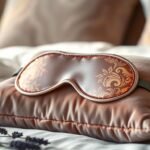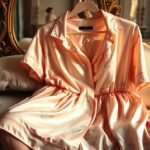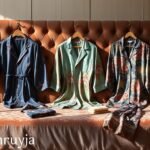Imagine a fabric that moves like a dancer, shining brightly. This is silk charmeuse, a luxury fabric loved for centuries. It’s known for its elegance and refinement. Let’s explore silk charmeuse and its timeless beauty.
Silk charmeuse is a fancy fabric with a shiny look and a smooth feel. Made from 100% natural silk1, it has a bright side and a duller back. This makes it look special. The process of making it includes degumming, dyeing, and calendaring1. This gives it a beautiful sheen and a soft feel.
Silk charmeuse has a long history, starting in ancient China over 5,000 years ago1. It was once only for the rich because of its beauty and rarity1. Now, it’s still a top choice for fancy clothes, bedding, and decor.
Key Takeaways
- Silk charmeuse is a luxurious, satin-like fabric made from 100% natural silk
- It boasts a smooth, shiny front and a slightly duller backside, creating a captivating visual contrast
- The fabric’s history dates back over 5,000 years to ancient China, where it was reserved for the ruling class
- Silk charmeuse is known for its fluid, lightweight drape and superior durability
- It is a popular choice for high-end fashion, bridal wear, and home decor
Introduction to Silk Charmeuse Fabric
Definition and Overview
Charmeuse is a shiny fabric on one side and dull on the other2. It’s named after the French word for “a female charmer,” showing its beauty and charm2. Now, it’s made from silk, rayon, polyester, and cotton, not just silk alone2.
The Etymology and History of Charmeuse
Charmeuse’s history goes back to ancient Asia, found as early as the 4th millennium BC2. It came to the West through Chinese traders or Western makers of textiles3. In the Middle Ages and Renaissance, the European upper class loved it for its shiny satin look3.
It stayed popular in the West even through the Enlightenment and celebrated women’s right to vote in the U.S2..
| Silk Fabric Types | Characteristics |
|---|---|
| Mulberry Silk | Most sought-after type of silk, commonly used in silk dresses, blouses, and lingerie4. |
| Tussar Silk | Derived from forest-dwelling silkworms, prized for its natural and earthy appearance, popular in traditional Indian garments like sarees and kurta4. |
| Charmeuse Silk | A glossy fabric with a satin finish, commonly used for evening gowns, lingerie, and scarves due to its luxurious draping properties4. |
| Dupioni Silk | Known for its slubbed texture, ideal for bridal gowns, suits, and formal wear4. |
| Organza Silk | A sheer and lightweight fabric used for overlaying dresses, bridal veils, and elegant blouses4. |
| Georgette Silk | A lightweight fabric with a grainy texture, often used in casual and semi-formal clothing like blouses, dresses, and scarves4. |
Charmeuse Fabric Production Process
The making of charmeuse fabric starts with getting silk fibers from silkworm cocoons on mulberry trees5. Silk workers boil the cocoons to get the silk fibers out. They then use brushes to find the loose ends and thread them through eyelets.
These fibers are twisted together to make strings. These strings are then twisted again to make the yarn for charmeuse fabric.
Weaving Techniques for Charmeuse
Charmeuse fabric gets its special look from a satin weave. This weave has four or more weft yarns on top of one warp yarn6. This makes one side shiny and the other side matte.
Most charmeuse is made on machines, but some is still made by hand on looms6. Synthetic charmeuse uses man-made fibers like polyester instead of silk.
The making of charmeuse shows the skill and art of textile workers. They use top-quality materials and careful techniques to make a fabric that is both elegant and sophisticated56.
Properties and Characteristics of Charmeuse
Charmeuse fabric is known for its unique and beautiful traits. It has a smooth, shiny side and a dull side on the back. This makes it look elegant and catches the eye7. The satin-like shine comes from a special way it’s made, which reduces light scattering. This creates a bright, glossy look.
Charmeuse fabric is also light and easy to move around in7. It’s very light, with a thread count of 12 to 30 momme. This makes it perfect for making beautiful, flowing clothes like dresses and nightgowns8. It’s also great for bedding and sleepwear because it’s soft and comfy.
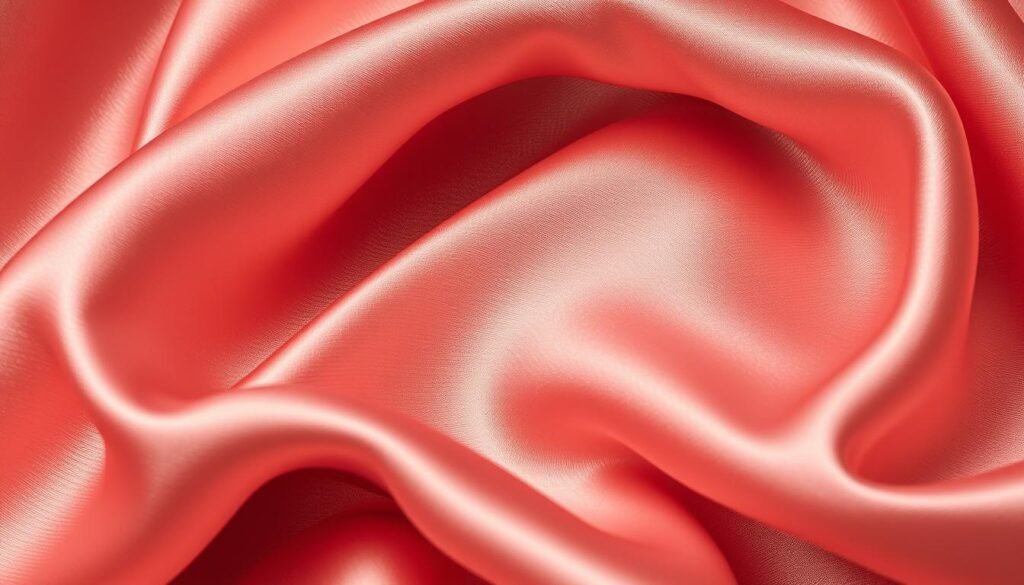
Charmeuse fabric is popular in fashion and textiles for its shiny look, light weight, and beautiful flow8. It’s used in fancy evening dresses, delicate lingerie, and plush bedding. Its special features make it a favorite for adding elegance and beauty to any item78.
What Is Silk Charmeuse Fabric? Understanding Its Elegance
Silk charmeuse is a luxurious fabric known for its beauty. It has a shiny side and a dull back. This makes it perfect for fancy clothes like evening dresses and lingerie. The fabric’s smooth, light feel and flowing style add to its luxury9.
For centuries, charmeuse was a treasure in ancient China, only for the royal family. Now, silk charmeuse is still a sign of luxury and style. Top designers use it for their most fancy items10.
The beauty of charmeuse fabric elegance is how it moves smoothly, creating a soft look. Its charmeuse fabric luxury comes from its soft sheen. This sheen catches light and makes any outfit look amazing9.
“Silk charmeuse is the quintessential fabric of elegance and refinement. Its captivating sheen and fluid movement make it a favorite among designers and fashion enthusiasts alike.”
What is silk charmeuse fabric shows the lasting beauty of silk. It adds timeless style to any design10.
Uses of Charmeuse Fabric
Charmeuse fabric is a favorite in fashion and home decor for many reasons11. It has a smooth, shiny look and feels light and flowy. This makes it perfect for lots of uses.
Charmeuse for Apparel
Women love charmeuse for fancy dresses, evening gowns, and lingerie11. It makes clothes look elegant and hugs the body nicely. Men use it too, for ties, handkerchiefs, and sports jacket linings, adding a fancy touch11.
Charmeuse for Bedding and Home Decor
For bedding, charmeuse is a top pick for its soft, shiny feel11. It’s also used for drapes and furniture covers, but not as much11. Its luxury and versatility make it a favorite for high-end fashion and home items.
People love charmeuse for being soft, safe for allergies, and keeping a steady temperature11. Silk charmeuse is a big hit for weddings and parties11. Stretch charmeuse satin is great for snug clothes and curtains11. Poly charmeuse is cheaper and easy to clean, but still looks and feels like silk11.
| Fabric Type | Market Share |
|---|---|
| Mulberry Silk | 90% |
| Charmeuse Silk | 5% |
| Tussar Silk | 3% |
| Dupioni Silk | 2% |
Charmeuse is a top pick for many uses, from fancy clothes to beautiful home decor1112. Whether it’s silk, poly, or stretch satin, charmeuse wins hearts with its amazing looks and feel.
Comparing Mulberry Silk and Charmeuse Silk
Mulberry silk and charmeuse silk are both luxury fabrics. But they are different. Mulberry silk comes from silkworms that eat mulberry leaves. It is the best silk because it is soft, strong, and safe for people with allergies13. Charmeuse silk is made with a special satin weave. It has a shiny finish and flows beautifully13.
Making mulberry silk is special. The fine fibers make it very soft and long-lasting13. Charmeuse silk gets its shine from a special way of weaving13. This makes it perfect for fancy clothes and decorating your home14.
Mulberry silk is great for bedding and sleepwear because it lets air in and keeps you cool13. Charmeuse silk is better for clothes that need to flow and look elegant13. Choosing between the two depends on what you want to use it for and your personal taste13.
| Characteristic | Mulberry Silk | Charmeuse Silk |
|---|---|---|
| Fiber Source | Silkworms that feed exclusively on mulberry leaves13 | Produced using a satin weaving technique13 |
| Appearance | Fine, smooth, and lustrous fibers13 | Smooth, glossy, and flowing13 |
| Durability | Highly durable due to long, continuous fibers13 | Susceptible to pilling compared to mulberry silk13 |
| Breathability | Excellent breathability and temperature regulation13 | Lightweight and breathable, suitable for various climates13 |
| Applications | Bedding, sleepwear, and formal wear13 | Formal wear, home decor, and flowing garments13 |
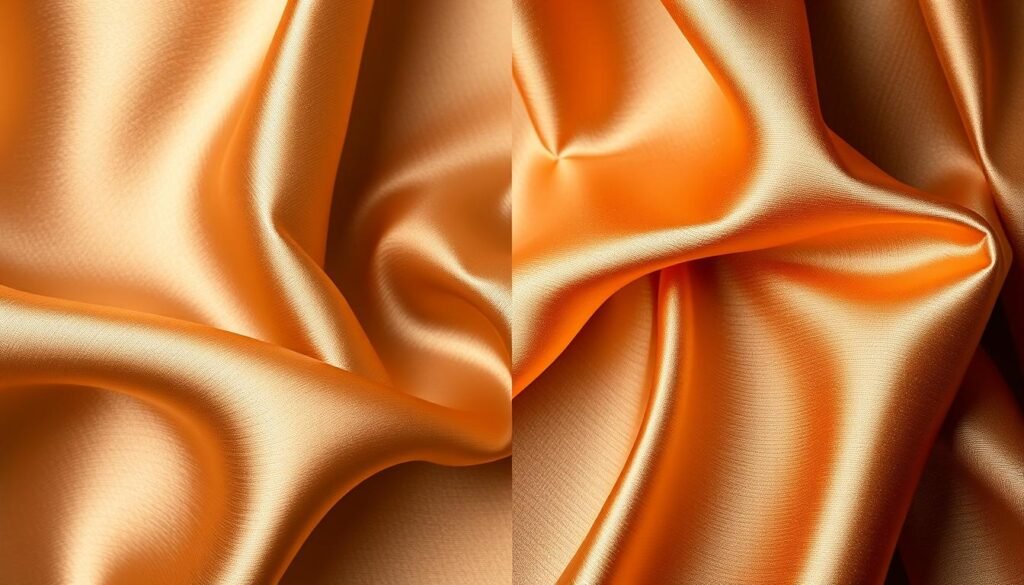
In conclusion, both mulberry silk and charmeuse silk are luxurious and high quality. The choice between them depends on what you want to use it for and your personal taste13. Taking good care of them is important to keep them soft and strong13.
“Silk is the queen of textiles and the textile of queens.” – Louis XIV
Environmental Impact of Charmeuse Production
The way charmeuse fabric is made affects the environment. Silk charmeuse is made from silk and is kind to the planet15. It doesn’t use harmful chemicals or take up too much land15. But, it can still hurt local ecosystems if workers are treated poorly because of poverty15.
On the other hand, synthetic charmeuse fabrics like polyester and rayon are bad for the environment15. They pollute our water and don’t break down easily15. Even recycled synthetic fibers aren’t as good as real silk charmeuse15.
People are working to make silk production better for the planet15. There are special labels like GOTS, OEKO-TEX, and the Better Silk Initiative to help15.
In summary, the environmental effect of charmeuse fabric depends on its material. Real silk charmeuse is better for the earth than synthetic ones15. By choosing ethical and certified silk, we can help make the charmeuse industry greener.
Care and Maintenance of Charmeuse Fabric
It’s key to take good care of charmeuse fabric to keep it looking luxurious16. This delicate silk fabric needs to be handled with care to stop it from getting snagged or pulled17. When washing, use a gentle silk detergent and cool water17. Always wash it alone or with other soft items to keep it safe.
Letting it air-dry is best for charmeuse, as machines can shrink or damage it17. For small stains, clean with mild soap and cool water, then air-dry17. Keeping it folded or hung up right is also key to keeping it smooth and shiny16.
Washing and Cleaning Instructions
- Use a gentle, silk-specific detergent and cool water to wash charmeuse fabric.
- Wash charmeuse separately or with other delicate items to prevent damage.
- Air-dry charmeuse to avoid shrinkage or damage from machine drying.
- For spot cleaning, use a mild soap and cool water, followed by air-drying.
- Store charmeuse by folding or hanging to maintain its smooth, lustrous appearance.
“Charmeuse is known for its high sheen, smooth texture, and elegant drape.”17
| Fabric | Composition | Characteristics | Care Instructions |
|---|---|---|---|
| Charmeuse | Silk or synthetic fibers | Smooth, shiny surface, elegant drape | Hand wash or machine wash on delicate cycle, air dry |
| Mulberry Silk | 100% natural silk fibers | Soft, durable, hypoallergenic | Hand wash or machine wash on delicate cycle, air dry |
Proper care and maintenance are essential for preserving the luxurious qualities of charmeuse fabric.16
Conclusion
As we wrap up our look at silk charmeuse fabric, it’s clear it’s a timeless piece of luxury. It has been a symbol of elegance for centuries. Charmeuse fabric has been loved by fashion and home décor fans for a long time18.
This fabric shines like satin and feels incredibly soft. It’s also breathable and keeps a good temperature. These qualities make it perfect for many uses, like dresses, lingerie, bedding, and more18. It’s a favorite, whether it’s real silk or a synthetic version18.
We should think about how making charmeuse affects the planet. Let’s choose sustainable ways to keep its beauty and reduce harm to the environment. With the right care, silk charmeuse can last for many years. It shows the lasting beauty and luxury of this special fabric1819.
FAQ
What is the definition and history of charmeuse fabric?
Charmeuse is a fancy fabric with a shiny side and a dull back. It’s often made from silk, but can also be polyester or rayon. The name comes from the French word for “a female charmer,” showing its elegant nature. It has a long history, dating back to ancient China where only royalty wore silk.
How is charmeuse fabric produced?
Making charmeuse starts with getting silk from silkworms that eat mulberry leaves. Then, silk yarn is woven into charmeuse using a special satin pattern. This method makes the fabric shiny on one side and dull on the other.
What are the properties and characteristics of charmeuse fabric?
Charmeuse is famous for its smooth, shiny side and its dull back. This look comes from the satin weave used to make it. It’s also light and flows well, with a thread count between 12 and 30.
How is charmeuse fabric commonly used?
Charmeuse is often used in fancy women’s clothes like evening dresses and lingerie. Its smooth look and flowy feel make it great for creating beautiful shapes. It’s also used for luxury bedding because it’s soft and looks nice.
What are the key differences between mulberry silk and charmeuse silk?
Mulberry silk comes from silkworms that eat mulberry leaves and is the best quality silk. It’s super soft, strong, and safe for people with allergies. Charmeuse silk, on the other hand, is a satin fabric with a shiny side and a flowing look. It’s used for clothes that need to be fancy and elegant.
What is the environmental impact of charmeuse fabric production?
Making charmeuse fabric affects the environment in different ways, depending on the material. Silk charmeuse is pretty good for the planet because it doesn’t use harmful chemicals or take up a lot of land. But synthetic charmeuse, made from polyester and rayon, is bad for the environment. These materials are made with chemicals that harm our water.
How should charmeuse fabric be cared for and maintained?
To keep charmeuse looking great, it needs to be handled with care. Avoid snagging or pulling the fabric. When washing, use a special silk detergent and cool water. Let it air dry to prevent shrinkage or damage.


